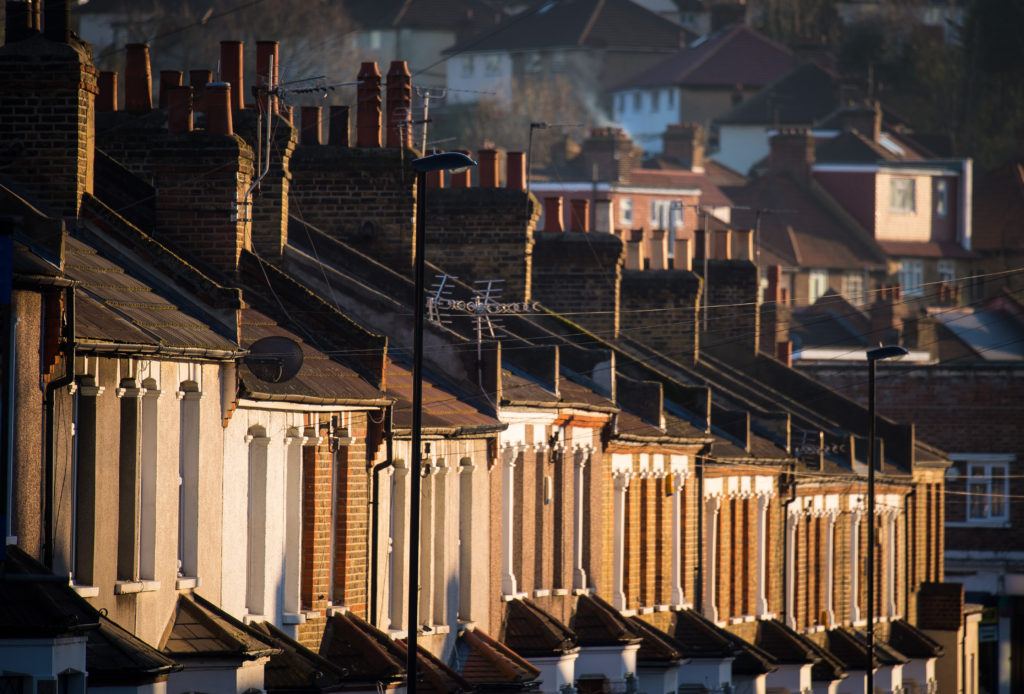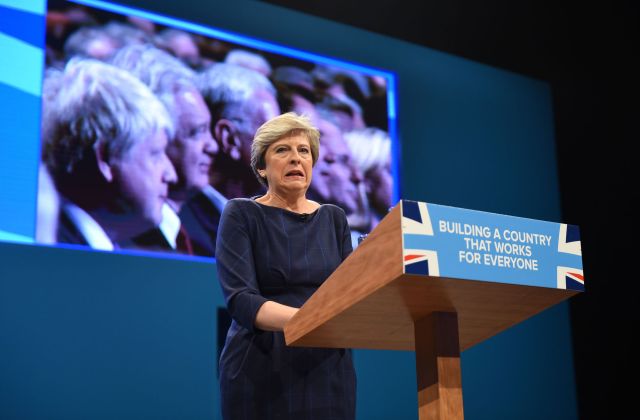Picture by: Joe Giddens/PA Wire/PA Images

“Our housing shortage leaves the door open for Premier Corbyn“.
That was the title of a column I wrote for The Sun in October 2016. Back then, while some of us were deeply concerned about the UK’s housing crisis, and understood its electoral implications, the issue very rarely made political headlines. A year on, all that has changed.
During numerous fringe meetings I attended at the annual Conservative party conference in Manchester, as well as platform speeches in the main hall, ‘we need to do something about housing’ seemed to be a compulsory part of every Tory politicians’ message.
The Conservatives’ June 2017 election disaster, in which Prime Minister Theresa May lost her parliamentary majority of course, has catapulted housing to the top of the domestic policy agenda. The reality has finally dawned on the UK’s governing party that millions of young adults – even highly-educated professionals, who should be natural Tory voters – simply cannot buy a home.
It was the collapse in support among this crucial 25-45 year-old demographic which, above all, explains why May’s mid-summer election gamble backfired. Countless younger voters are now locked out of an overly-inflated property market, where average house prices are no less than eight times greater than average wages – an historically-high multiple impossible to finance with a regular mortgage.
That’s why half of first-time buyers who do manage to get on the property ladder are now dependent on a sizeable contribution from ‘the bank of Mum and Dad’, rising to two-thirds in London and the South East – an option, of course, which isn’t available to many. The UK housing market – once a source of social mobility and security for those willing to work hard and save – is now generating widespread frustration, discontent and even anger.
Young adults faced with the slammed door of housing unaffordability, forced to endure sky-high rents in London and elsewhere, flocked to Jeremy Corbyn’s Labour party last June. They did so not because they back his hard-Left agenda, but because ‘the system’ simply isn’t working for them. Corbyn came within a whisker of grabbing power – winning 40% of the national vote, compared to May’s 42% – in large part because so many young adults, locked out of the housing market, felt they had nothing to lose.
This is the backdrop against which May gave her conference speech in Manchester. It was a speech billed as containing “a big offer” on housing. On that criterion, the Prime Minister – unforgivably – just missed a huge opportunity.
Yes, she was unlucky. Her conference set piece, designed to re-launch her Premiership, was marred by an unfortunate coughing fit and a scheming prankster – who, in my view, having deliberately sparked a major security scare, should face criminal prosecution. But the speech, had it been perfectly delivered, was anyway painfully thin on policy – and nowhere was this more evident than housing. May seems to understand neither the extent nor the implications of this problem, let alone showing the intellectual and political courage required to implement effective solutions.

More than twice as many voters under the age of 45 now think Labour is “on their side” compared with those who believe the same about the Tories, according to a new poll by Opinium for the Social Market Foundation. The poll suggests only 26% of 25-34 year olds and 25% of 35-44 would consider voting Conservative. Among those ages 65-74 the figure is 51%.
Heavy Labour support among students and 20-somethings isn’t unusual. What is new – and potentially disastrous for the Conservatives – is that those in their 30s and early 40s, missing out on the security and invested wealth of home-ownership, which is in turn driving lower family formation, aren’t ‘graduating’ to the Tories. People with no capital, after all, are unlikely to back capitalism. It’s almost become a political cliché. The Conservative party is the party of broad home ownership, or it is nothing. Given that, the ‘bold housing policies’ I was promised by numerous ministers during this Tory conference somehow didn’t make it into May’s final speech. What she did propose, in fact, will actually be counterproductive.
For decades, far too few homes have been built in the UK. Under governments of all stripes, house building has fallen woefully short of what is needed to accommodate even the natural expansion of British population, let alone immigration. The result has been spiralling prices and the emergence of ‘generation rent’.
Back in 2013, rather than taking measures to rein in prices by ensuring more homes are built, the Tories made the disastrous error of stoking up the demand side of the housing market via its ‘Help to Buy’ (HTB) scheme. In her conference speech, May compounded that error by confirming an additional £10bn will be pumped into the scheme. This is madness.
There is so much wrong with HTB. It sounds fine in theory – allowing people to buy a new home with a deposit worth only 5% of the cost and a low-interest equity loan from the government. But, in practice, it has made a bad problem even worse.
For one thing, HTB only applies to new-build homes – and, since its introduction, powerful developers have used the demand spike to sell a slew of small, low-quality homes, racked with faults and often on extremely punitive ‘leasehold’ ownership structures, which require on-going payments and makes homes difficult to sell.
HTB is a huge cash bonanza for the already extremely powerful large developers that dominate the UK’s housing industry, a sector that a recent House of Lords report described as showing “all the characteristics of an oligopoly”. When news that a new dollop of HTB was in the offing was reported ahead of May’s speech, the UK’s biggest house-builders added £1bn to their market value in a single day.
The government estimates that around 135,000 new homes have been bought under HTB, and it hopes for a similar number from this new funding. Yet, the scheme is very tough to access and the overwhelming effect of it, not withstanding those it has helped, is to juice up the market even more, pushing prices even further out of reach for the vast majority of those trying to claim a stake in the property market, as they look to settle down and raise a family.
“The real problem of course, is a chronic lack of supply,” said John Longworth, former President of the British Chambers of Commerce. “HTB is fine for those get the help but it won’t address the real problem,” Longworth told me in Manchester, “and the real problem is the UK’s greedy large developers who are banking land”.
The Adam Smith Institute has panned HTB. The UK property market is “totally dysfunctional because supply is so tightly constrained” says the influential free-market think tank:
“Adding more demand without improving the supply of houses is just going to raise house prices and make homes more unaffordable for people who don’t qualify for the help-to-buy subsidy.”
Rather than injecting more taxpayers’ cash into a property market already bloated by a glaring demand-supply imbalance, to say nothing of the inflationary impact of a massive ‘quantitative easing’ programme which has now endured for almost a decade, the government needs to take drastic steps to ensure more homes are built.
Even Shelter, the highly-respected housing charity, has criticised HTB, saying last year that it “barely helped the first-time buyers it is targeted at”. Yet, still, May has taken the easy option of extending the all-powerful large house-builders another bung. She deserves the negative headlines. When the Adam Smith Institute and Shelter agree, you can be sure there is a major problem.
The problem is that May is failing to loosen rules to allow the construction of more homes in high demand areas – including in her own ‘green belt’ constituency of Maidenhead, to the west of London. Since taking office in 2010, the Tories have also allowed the UK’s highly-concentrated house-building industry to amass vast landbanks and delay the conversion of planning permissions in actual homes, boosting prices and profits by imposing a deliberate house-building go-slow.
At the 2016 Conservative party conference, during this platform speech, Communities Secretary Sajid Javid called time on the large house builders. “The big developers must release their stranglehold on supply,” he said. “It’s time to stop sitting on land banks and stop delaying build-out. The homebuyers must come first”.
Earlier this year, Javid produced a housing white paper which originally contained radical measures to punish developers who hold back supply by breaking agreed limits on how quickly planning permission should result in saleable homes. The measures were watered down, though, rendered almost toothless, just as the developers wanted.
Small and medium-sized builders, meanwhile, who accounted for three-fifths of all home built in Britain in the mid-1980s, now account for less than a fifth. Unable to access adequate land, and often starved of bank finance, the smaller builders – vital to spur competition, and get houses built fast – are increasingly pushed out by the ‘big boys’. More HTB does nothing to help those builders, and by stoking up demand while doing nothing to unlock supply it makes a bad position even worse.
The other aspect of May’s “bold housing offer” in Manchester was a promise to build more government-owned social housing – homes with heavily-subsidised rents, made available to low-income workers. For decades, the construction of social housing has been risibly low – falling to single digits hundreds per annum under Tony Blair during the early 2000s, and still in the low single-digit thousands. If the UK is to build the 250,000 new homes needed each year, then that needs to include some 50,000-100,000 units of social housing required each year. From the conference stage, May offered, “an extra £2 billion in funding for affordable homes” – which is chicken feed. That will pay for around 25,000 new homes, or just 5,000 a year during the period the new funding will be introduced. This is risible.
Ten years ago, almost three fifths of 25 to 34 year-olds owned their own home. Now it’s under two-fifths. Twenty years ago, over 40% per cent of under 25s owned a property. Today it’s less than 20%. Many young and even middle-aged adults, particularly in London and the south east, can see no route out of renting. Meanwhile, the Prime Minister offers 25,000 new council houses in the face of a waiting list that is 1.2m strong. And those 25,000 might not even transpire.
“I will dedicate my premiership to fixing this housing problem,” May told the party faithful in Manchester. If she and those around her don’t grab this problem by the scruff of the neck, demonstrating they understand the extent of our housing crisis, and are willing to impose tough measures to fix it, her premiership will soon be over. Deservedly.










Join the discussion
Join like minded readers that support our journalism by becoming a paid subscriber
To join the discussion in the comments, become a paid subscriber.
Join like minded readers that support our journalism, read unlimited articles and enjoy other subscriber-only benefits.
Subscribe